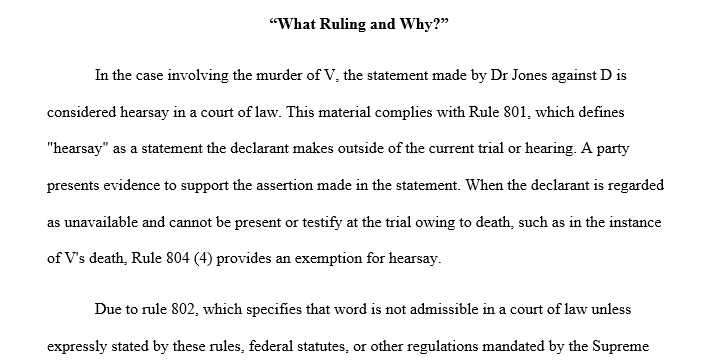Answer each of the following questions in essay form discussing the relevant rules from the Federal Rules of Evidence. “What ruling and why?”
Answer each of the following questions in essay form discussing the relevant rules from the
Federal Rules of Evidence. “What ruling and why?” means you are the judge – what ruling
would you make in the various scenarios and explain them under the Rules where asked. Essay
answers will be typed in 12-pt. Times New Roman and double-spaced. Words minimums are just
that — minimums and are mere estimates to what it takes to fully answer a question. PUT ALL
ANSWERS IN ONE DOCUMENT.
The Federal Rules of Evidence can be found here: https://www.law.cornell.edu/rules/fre
- Charge: murder of V. Dr. Jones is called to the stand by the prosecution. At D’s
request the judge first listens to Dr. Jones’s testimony out of the presence of the jury.
Jones states that just before V died, Jones said to her, “You are very badly wounded,”
and that shortly thereafter V mumbled, “D did it.” The judge thinks that V probably knew
she was dying but recognized that reasonable people might differ on that question. The
judge also thinks that V probably did not say, “D did it,” but rather mumbled something
else which the doctor misunderstood, but the judge recognizes that reasonable persons
might also differ on that. Defense counsel objects to Jones’s being allowed to testify
before the jury. What would be source of the objection? What ruling on the objection
and why? (250-word minimum).
- Action against D Supermarket for injuries allegedly sustained when P slipped and fell
while shopping in the D store. P claims he slipped on ketchup from a broken
bottle. D claims P slipped on a wad of tobacco from P’s mouth. W, a customer in the
store who rushed to P’s aid while P was lying unconscious on the floor, is P’s first
witness at trial. W testifies that she saw ketchup on the soles of P’s shoes after the fall.
On cross-examination defense counsel questions W’s perception, memory, and veracity
but fails to make much progress. Verdict is for P, but when the jury is polled it is
discovered that the panel consists of only 11 people. A mistrial is declared. On
retrial, P introduces evidence that W is dead and calls R, the court reporter from the first
trial, to testify that he remembers W’s former testimony and to relate it. D objects.
What ruling and why? What reasons justify the use of former testimony of an
unavailable witness? What are the dangers and drawbacks of the use of this type of
evidence? What limitations should be imposed on the use of former testimony? (500
word-minimum)
3. Defendant is on trial for murder. The evidence is that defendant’s husband was shot twelve
times as he stood in the shower. Defendant does not contest the commission of the act, but pleads
self-defense. Defendant testifies on her own behalf.
Answer preview for Answer each of the following questions in essay form discussing the relevant rules from the Federal Rules of Evidence. “What ruling and why?”

APA
2317 Words